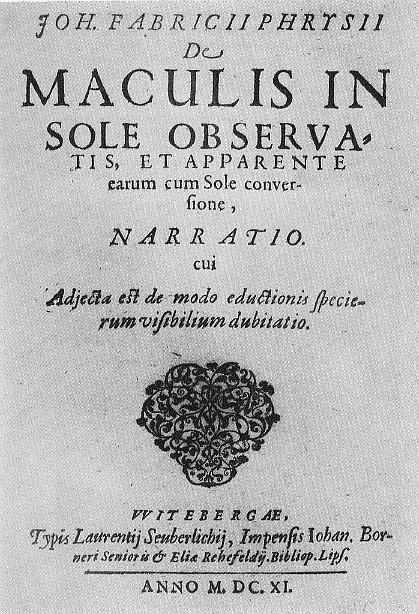As I have commented on more than one occasion Galileo was not the only European astronomer to point a telescope at the heavens in the first years after its invention in Holland in 1608. In fact all of the telescopic discoveries for which Galileo is famous were made independently by other observers in the same period and if he had never existed it would have made little or no difference to the development of telescopic astronomy. These parallel discoveries often led to bitter priority disputes between the Tuscan mathematicus and those rash enough to claim independent discovery. A famous example is the pamphlet war between Galileo and the Jesuit astronomer from Ingolstadt, Christoph Scheiner, as to who first discovered the sunspots. The irony of this particular priority dispute is that the English astronomer Thomas Harriot discovered the sunspots before both of them and the first to publish the telescopic discovery of sunspots was Johann Fabricius, the eldest son of the Frisian village priest and amateur astronomer David Fabricius, who was born on 8th January 1587.
Johann originally acquired his knowledge of mathematics and astronomy working alongside his father who was one of the leading European astronomers. In 1604 he began to study at the University of Helmstedt where his father had also studied but in 1606 he changed from Helmstedt to the University of Wittenberg, home of the Reformation. His studies were supported by Count Enno III of East Frisia who was also a patron of his father. In 1609 he moved again to the University of Leiden at this time one of the leading European universities. It was from Leiden that Johann returning home in the winter of 1610 brought a telescope. It is probable that he became aware of this wonderful new astronomical instrument through Rudolph Snel van Royan, the father of Willibrord Snel van Royan who gave his name to Snell’s law of refraction. Rudolph was professor of mathematics in Leiden and was already holding, probably the first ever university, lectures on the telescope in 1610.
Johann and his father experimented with this new instrument and on 27th February 1611 Johann pointed his telescope at the sun and observed for the first time a sunspot. Due to the difficulties of direct solar observation he quickly changed to indirect observation with a camera obscura, a standard method of solar observation, to make a series of systematic observations. Returning to Wittenberg in 1611 Johann published the results of his observations in a 22 page pamphlet his De Maculis in Sole observatis, et apparente earum cum Sole conversione, Narratio, etc. Witebergae, Anno M.DC.XI. In their dispute both Galileo and Scheiner ignored Fabricius’ publication of which in all fairness they might not have been aware.
Johann graduated MA in Wittenberg on 24th September 1611. He went on to study for a doctorate in medicine but died under unknown circumstances sometime between 9th March 1616 and 7th May 1617.
It should be pointed out in all the disputes in the 17th century as to who first discovered or first published the discovery of sunspots that they had been discovered and recorded with naked eye observations over the centuries by Chinese, Islamic and Mediaeval European observers but unlike the telescopic discoveries the earlier observations had no real impact on the development of astronomy. One irony of the history of astronomy is that Kepler, the only person to acknowledge Johann’s priority in publication had himself observed a large sunspot in 1607 with a camera obscura, a name that he coined, but mistakenly thought he was observing a transit of Mercury.
The Fabricii, father and son, remain largely unknown to the world at large but a monument to them both was erected in the churchyard in Osteel, where David had been village pastor, in 1895.



Pingback: Spotting the spots. | Whewell's Ghost
There is an article on Google Books: “The Discovery of the Sunspots” by M.A. Lancaster, in Popular Science Monthly, Sept. 1897, that puts Harriot last among the discoverers, Galileo first (summer of 1610), and refers consistently to Scheiner as “the false Apelles”. He also indicates that while both Galileo and Scheiner had seen sunspots before Fabricius, neither attached much importance to them until after Fabricius’ tract appeared. At that point both men began meticulous measured observations, though Lancaster credits only Galileo. The link that might take you there is:
http://books.google.com/books?id=4iIDAAAAMBAJ&pg=PA681&lpg=PA681&dq=Kepler+Fabricius+sunspots&source=bl&ots=Mgqm6vQ-nK&sig=jj20hCN8l1npInsTjcXpPIgEyfc&hl=en&ei=EvAwTfjcAovksQOmlJi-BQ&sa=X&oi=book_result&ct=result&resnum=2&sqi=2&ved=0CCIQ6AEwAQ#v=onepage&q&f=false
Yeah, “Popular Science Monthly”. But he does seem to have some ducks lined up. Comments?
Pingback: Questions on spots | The Renaissance Mathematicus
wilfried schroeder has been published a book
johann fabricius and the discovery of the sunspots, bremen, 2009
may you add this
Pingback: Calendrical Confusion or The Dangers of Dating! | The Renaissance Mathematicus
Pingback: Apelles hiding behind the painting | The Renaissance Mathematicus
Pingback: Science grows on the fertilizer of disagreement | The Renaissance Mathematicus
Pingback: The weather and the stars | The Renaissance Mathematicus
Pingback: 2 – The Discovery of Sunspots (2011) | Offer Your
I’ve been wondering of late about the “Great Men” approach to history. And I wonder if perhaps there might be some truth in it after all. While Galileo and most other “Great Men” (and women) often achieved their greatness through tireless self-promotion, isn’t it also true that they were tirelessly promoting the discoveries? One could argue that this tireless promotion of new and world-changing ideas is an essential element in having those ideas actually change the world. And so on the one hand we might argue for the inevitability of certain discoveries, on the other we have to acknowledge that getting those ideas out into the world may be, all by itself, worthy of a little bit of greatness.
Pingback: Whewell’s Gazette: Year 3, Vol. #30 | Whewell's Ghost
Pingback: Bringing the heavens down to earth | The Renaissance Mathematicus
Pingback: Observing for the long haul | The Renaissance Mathematicus
Pingback: Like father like son | The Renaissance Mathematicus
Pingback: Getting Galileo wrong yet again | The Renaissance Mathematicus